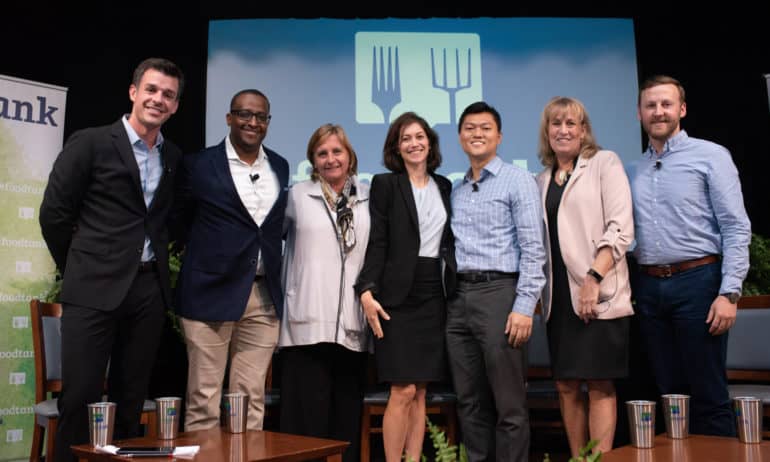At the Second Annual NYC Food Tank Summit on food loss and food waste, Ben Tinker, Supervising Producer of CNN Health, leads a panel discussion on improving food recovery. The panel highlights a shift in thinking of food recovery as not an act of charity, but rather a service.
Food recovery, also called food rescue, refers to the recapturing of food ready for consumption that would otherwise go to waste. In most cases, excess food is recovered from companies and institutions and given to places like food banks and soup kitchens. For waste removal services and nutrition delivery services, both the recipients of rescued food as well as the companies who provide the food should be viewed as customers in this transaction, according to the panel.
For these food rescue services, there has been an increased focus on the nutritional needs and preferences of recipients—more choice is being introduced.
“In terms of innovation, [New York Common Pantry] went from someone calling and saying we want to make a donation—and donating whatever they wanted—to using a google form that gets posted on the site every day with what the recipients want and what the Pantry needs,” says André Thompson, Director of Food Programs, New York Common Pantry. “It has revolutionized the way donations are made and what is received.”
The ability for recipients to choose their food means they are able to fill in their specific nutritional gaps and to choose foods that are sensitive to their food preferences, cultural choices, and dietary restrictions. A shift away from a charity model means that, “Instead of saying ‘here is your box of food,’ we are saying, ‘what do you need?’” says Karen Hanner, Vice President of Manufacturing Partnerships for Feeding America.
And, traditionally, says Bonnie McClafferty, Director of Food Value Chain at the Global Alliance for Improved Nutrition, the biggest challenge of food rescue has been taking in foods that are nutritious.
Elizabeth Balkan, Director of Food Waste at the Natural Resources Defense Council (NRDC), emphasizes the need to move away from a charity model and to view food waste removal as a service that food rescue operations are providing to companies. More discussion is needed about how this service could be paid for in some sustainable way through cost-sharing or other payment models, the panelists agreed. A move away from the charity model would reduce food rescue organizations’ dependence on foundation and donor funds for support and help food rescue operations to be more self sustaining.
Chris Cochran, Executive Director of ReFED, thinks a big innovation in food rescue is creative business models along with talking to companies about the financial benefits of dealing with food waste. Companies care about their pocketbooks. “When CFOs start paying attention to this issue, everybody lines up,” Cochran adds. “Presenting the business case can be highly effective.”
Hanner says that ever since the landmark NRDC Wasted report came out detailing food waste, “we’ve had the ability to talk about the financial benefit. For the first time, the protein industry is admitting they have waste in the system. They are now saying yes, we have surplus, and it’s going to landfills. Now, they are having conversations.”
Watch the full NYC Summit panel on Improving Food Recovery, above.











